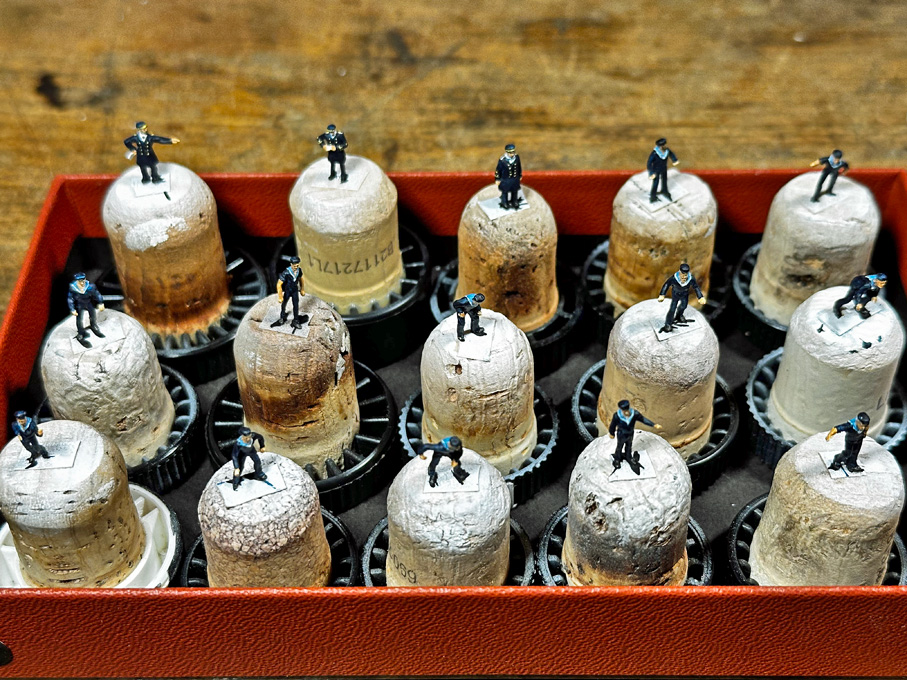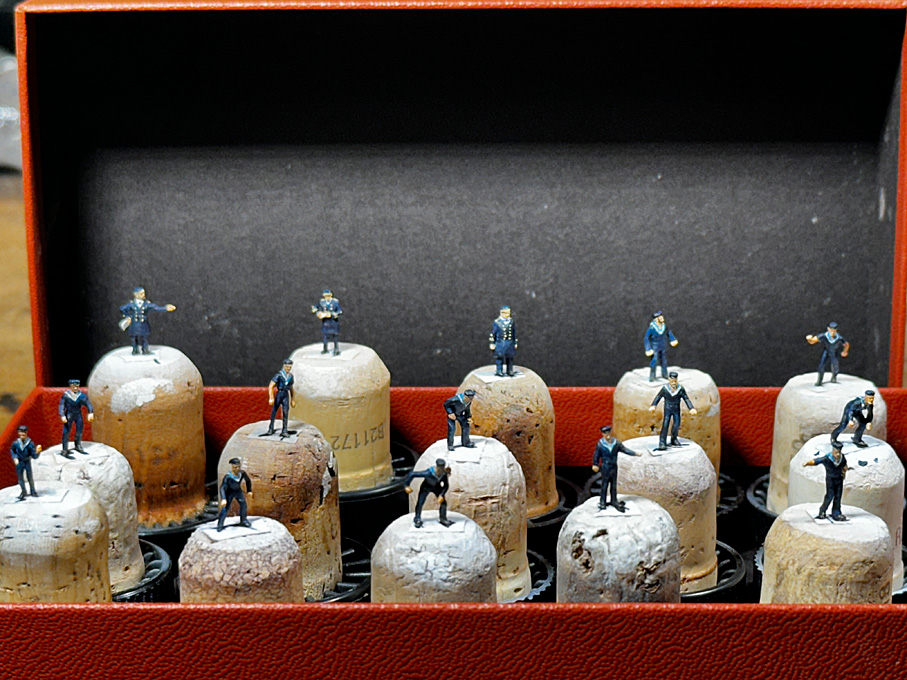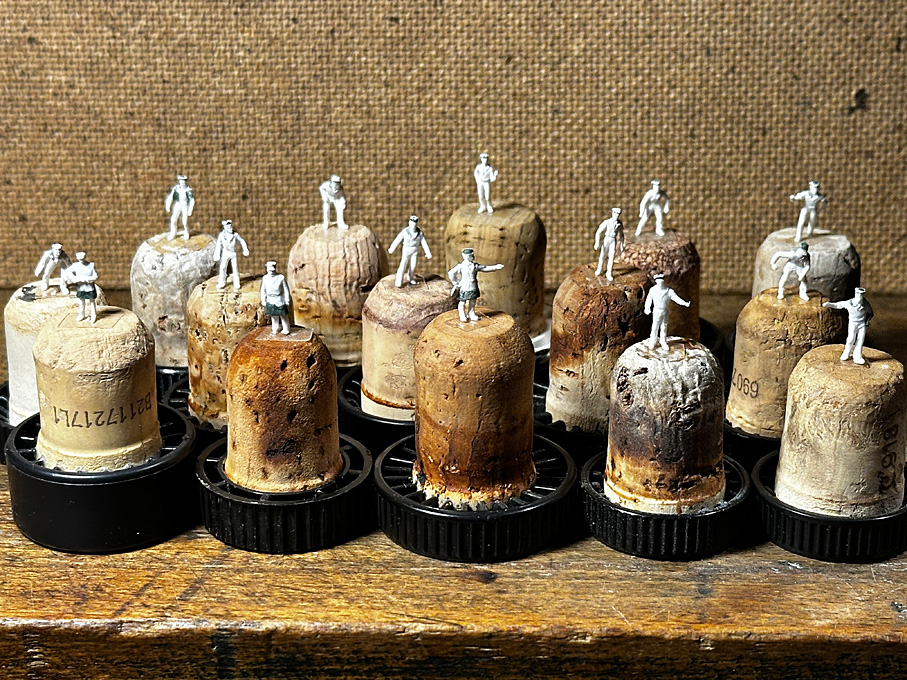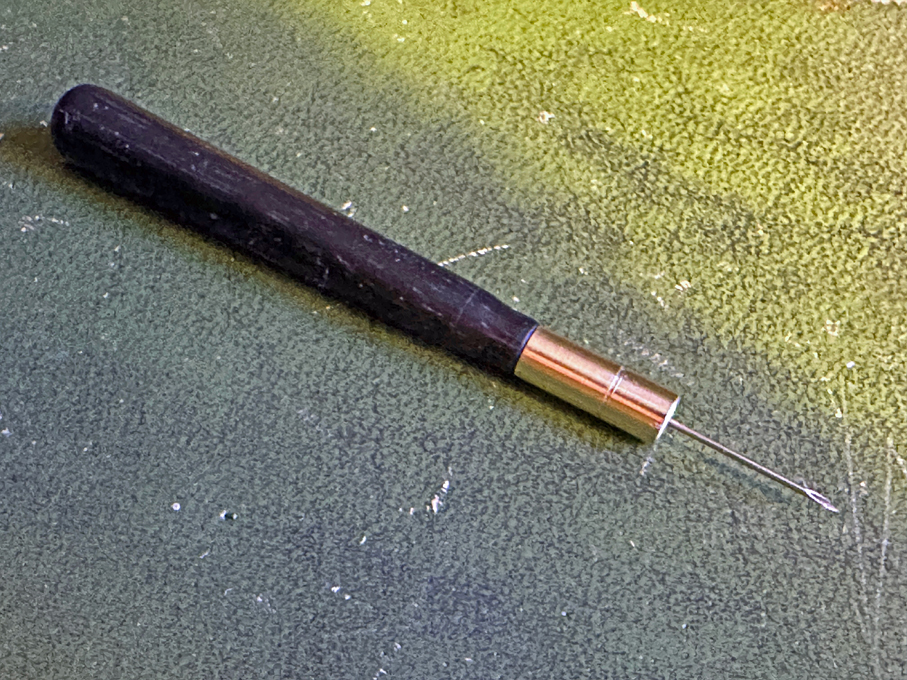-
Posts
6,358 -
Joined
-
Last visited
Content Type
Profiles
Forums
Gallery
Events
Everything posted by wefalck
-
Already another month passed, but not idle, albeit interrupted by several travels ... ******************* Painting the figures In order to better see how the sculpting turned out and any imperfections, the figures were given a spray-coat of matt white paint (Vallejo Model Air). This also served as a primer that made hand-painting easier. I like the consistency of Vallejo Model Air paints also for application by brush, but several coats may be needed for certain colours. The crew figures with a white base-coat Unfortunately, only at a relatively late painting stage some molding flash was noticed that could not be removed anymore. Also, it turned out, that some faces were actually not molded very well, which made it difficult to paint them. Painting such small figures requires a bit of a strategy. However, regardless of scale, I usually begin with the face and any other exposed skin. The reason is that, apart from white, most other clothing colours tend to be darker and have a better coverage and perhaps more importantly, clothing covers the skin, so in order to get precise edges between the clothing and the skin, it is more natural to paint towards the skin, rather than trying to approach the clothing with the skin colour. At this scale no attempt is made to paint eyes and such details, but rather to paint the shadows under the eyebrows and in other parts of the face. I find the way of how Canaletto treats the staffage in his paintings a useful reference. It is fascinating, how he can bring the ‘people’ to life with just a few brushstrokes and blobs of paint. Almost completed paint job on the crew figures It may be counterintuitive, but it is sometimes better to begin with painting details and then work with the main colour towards them. Or to use an iterative procedure: painting say the main colour of the clothing, then adding detail, followed by touching up with the main colour, where the brush had gone astray. Narrow lines, such as embroidery, are difficult to achieve, but too wide lines can be reduced in width by painting the main colour against them. The painting proceeded in several iterations and I have not taken pictures of the various steps. The crew ready to go on board The Vallejo Model Air paints have a slight satin sheen, which is good for many applications, but in order represent cloth better, the figure were given at the end a light spray coat with matt varnish. To be continued ....
-
BTW, if you repost pictures from other peoples' Web-sites, it would be polite to provide a reference to the source ...
- 62 replies
-
- belle poule
- OcCre
-
(and 1 more)
Tagged with:
-

Chairs! Let’s see your chairs.
wefalck replied to Desertanimal's topic in Modeling tools and Workshop Equipment
I am surprised that they are allowed to sell this still. I thought stools/chairs with three or four casters don't get a CE certificat anymore due to the risk of them tipping over and rolling away under your butt ... chairs have to have five casters these days. -
Some people, including myself, use hypodermic needles as marlinspikes for making false splices miniature rope. One has to blunt the edges a bit - they are obviously very sharp and meant to cut, but you don't want to cut your rope. You twist the rope a bit so that it splits and then you push the 'marlinspike' through. Now you can feed the free end into the needle and slowly pull it out with the rope inside - repeat and you will end up with a reasonable splice. As I had a nice ebony handle lying around (which may have come from some antique medical instrument from my fathers estate), I made a brass ferrule for it and cemented a hypodermic needle into it. I think it was a 20G (yellow). For serving, I would try to get hold of some 16/0 fly-tying thread, which is not fuzzy. Indeed, serving without some 'helping hands' is difficult. I tend to use half-hitches, rather than just winding the thread around. Each turn in this way can be set and does not come loose. Of course, having/building a serving machine would be the next step up ...
- 286 replies
-
I gather there various constructional and hydrodyamic factors play together. Modern freight carriers have a much higher L/B-ratio than these rowing boats. A long parallel midship section is not detrimental to water resistance, but rather encourages laminar flow. If you did cut out that part and stuck together the bow and stern sections, the overall shape would not be so dissimilar to that of the boats of old. One can only speculate how clinker building developed and Greenhill believes that it originates in expanding dugouts by adding planks while at the same time the dugout mutes into a sort of hollow bottom plank, eventually becoming the keel. This lends itself to smooth curves in (shell-first) planking with large radii. There is strength in flexibility in this construction as we know from experimental replicas. It is only with plank-on-frame construction that tight bends are possible, leading to a rigid skeleton with a shell around it (certain Dutch vernacular boats are probably the most extreme examples in that respect).
-
Talking about memories, I seem to remember a whole room being dedicated in the NMM in Greenwich to the Sutton Hoo find, where they showed a section of the boat in 1:1 of what it looked like after excavation: basically there were the imprints from the planks long gone and the remains of the iron rivets. I gather if several 'old codgers' get onto the same project that cuts down construction time compared to a single beavering away in his own workshop. Preparation and fitting times for planks are not so much different whether it's 1:1 or a model.
-
Another source for extremely thin, long-fibre 'Japan'-paper are supply shops for art- and book-restorers. This paper is used to 'invisibly' double up ripped or damaged book pages and works of art. I got one that has only has 8 g/sqm. For extremely fine woven fabrics serigraphy (screen-printing) supply shops are also an interesting source.
-

Chairs! Let’s see your chairs.
wefalck replied to Desertanimal's topic in Modeling tools and Workshop Equipment
I use a standard lifting office-chair with armrests. The inclination of the backrest can be also set. It was given to me for free as an office surplus. -
Somehow I haven't been aware of this project, thanks! One process that seems to be not so in line with how they did it in the old days is the use of templates. OK, they try to replicate an existing ship. In those old days they probably strung a cord from bow to stern and used this as reference to ensure that the boat turned out symmetrical, but otherwise everything would have been shaped by eye, I think.
-
Under the right light conditions and with the right background, this could look almost like the real thing 👍🏻
- 174 replies
-
- Vigilance
- Sailing Trawler
-
(and 1 more)
Tagged with:
-

HMCSS Victoria 1855 by BANYAN - 1:72
wefalck replied to BANYAN's topic in - Build logs for subjects built 1851 - 1900
I have both, single and double roller filing guides (or 'rests' as the watchmakers call it), but never really understood the value of a single roller guide ...- 993 replies
-
- gun dispatch vessel
- victoria
-
(and 2 more)
Tagged with:
-
... absolutely and if you are myopic in addition, this multiplies the magnification you get out of your myopia, when you take off your normal glasses. For years I got the 3x magnification by just replacing my normal glasses with plain safety-glasses. Now I need the additional magnification of reading glasses 😢
-
Don’t know USN practices, but on this side of the pond gaiters were worn - if at all - by landing parties only. So, you could perhaps show a landing party drill on deck. I tend to paint clothing etc. matt and anything flesh satin. Have been using mainly Vallejo Model Air paint even with a brush the last 15 years or so. Watching your progress …
-

HMCSS Victoria 1855 by BANYAN - 1:72
wefalck replied to BANYAN's topic in - Build logs for subjects built 1851 - 1900
Good to see here more progress indeed 👍🏻 These roller filing guides are useful implements. They used to be standard items on watchmakers lathes.- 993 replies
-
- gun dispatch vessel
- victoria
-
(and 2 more)
Tagged with:
-
There is no 'scale' for rivets, only size. So the question is how big on the prototype would these rivets be? Second question: what type of rivet? There are many ways in which rivetting and forming their heads can be performed: half round, countersunk (barely visible on a model), half countersunk, flush (which then would be invisible on the model), hollow rivets, etc. So a picture of the prototype you want to achieve would be needed to give you informed advice. I would, however, suspect that rivets in 1/200 scale on AA gun mounts would be rather small, with heads of a diameter somewhere around 20 mm max. This means, that in at a 1/200 scale we are talking of diameters of less than 0.1 mm. Assuming that we are talking of half-round heads, the only practical way would be tiny (really tiny) blobs of paint or white glue. It would be a challenge to achieve consistent sizes. In summary, I think I wouldn't bother. The tool you showed, although I don't know it, seems to be the kind used by aircraft modellers to indicate flush rivets by slightly marking the surface. This is not what you (presumably) need and the resulting marks would be grossly overscale anyway.
-
What I tend to do to such flat black parts is to run a soft pencil along the edges etc. to highlight them. Using a cotton stick, you can also slightly rub the graphite away from the edges. Similarly, using dark-grey pastel, you can lightly highlight areas that would normally be more illuminated to accentuate say round parts. Depending on how you want to show the model, pristine builders's model style or slightly 'weathered', you can add traces of ash or rust around the furnace of the boiler using white or brown pastels.
- 128 replies
-
- zulu
- sternwheeler
-
(and 1 more)
Tagged with:
-
Just stumbled across this log, while I am waiting for something to dry in my workshop ... I think the model looks very convincing and the strategy is good in the absence of real plans. There would have been, however, sources of plans for both, commercial and naval vessels built in and around Venice, that one could have explored. Venice at this time was under Austrian rule (formally Kingdom of Lombardia-Venezia) and the arsenal built for the Austrian-Hungarian navy - miraculously the archives largely survived two evacuations: 1866 to Trieste and 1919 from there to Vienna (though I seem to heard that many boxes are still unopend in the national archives there ...). So some lines plans that could have been adapated may have been there. Depending on, where the other ships your are modelling were built, this might be still a possibility. I like unconventional approaches to construction when it serves the purpose. At small scales wood is not always the best and most convenient material. Wood can also be messy to prepare, if you don't have a suitable workspace. And at small scale, the wood-grain is usually to coarse and needs to be covered up with fillers. So acrylic, styrene, bakelite-paper etc. can be indeed better options - even when the final surfaces are supposed to bare wood, as for decks. Painting may give a much more realistic appearance at small scales. At small scales real copper indeed probably is not the best material to represent coppered ships' bottoms. Very thin paper painted is a better way - I agree with you there. However, your overlapping plate-seams appear too pronounced, I must say. To be quite harsh (apologies), I think it spoils this lovely model somewhat. If you look at images of real coppering (me and others have posted a lot of pictures here on MSW), show that the seams are not very pronounced, as the copper-sheathing in fact was quite thin. I would have probably just butted the plates against each other, as even the thinnest paper would be overscale. Looking forward to further progress 👍🏻
-

Scale size questions
wefalck replied to Desertanimal's topic in Building, Framing, Planking and plating a ships hull and deck
The problem will be exacerbated when you work from scanned original drawings. Every line that is not absolutely aligned to the axis of the scanner will become a fuzzy, jagged something. There are a few strategies to overcome the problems discussed above: - never ever use chain measurement. By way of example, it you have a row of identical boxes fitted to each other, don't measure each individual box, but measure the overall length and divide it by the number of boxes to give you their dimensions. - Similarly, when drawing plans for a ship, do not start from the details, but from the overall dimensions and fit the parts in. The percentage lengths mentioned by Dr PR above go this way. - Think about the practicalities of building: what materials and what tools do I have available or can obtain; dimension parts accordingly, if the deviation would not really by visible. - Think also which part would the easiest to make fit to other parts; say you have to make a flange for a pipe, in which case you may fit the inner diameter of the flange to the available wire/round stock; the inverse, could be also the case for bigger parts, where it may be easier to turn the pipe to the diameter of a flange for which you had a drill for the whole; etc. - Unless I would make a drawing for publication, I tend to make no real drawings for parts, but rather (computer) sketches to which I add the measured/calculated dimensions; I then work from the numbers, rather than taking off another set of measurements from a drawing. - Work from parts with well-known dimensions; say, you need to construct a shell-locker, then start with the dimensions of the shell, which typically are very well documented in the literature of the time, etc. -
That's kind of strange, that the the bulkheads are behind the gun-ports. Normally, such laser-cut kits are well-engineered ... I gather you will have to show the lids closed in this case, at least the ones in front of bulkheads.
- 62 replies
-
- belle poule
- OcCre
-
(and 1 more)
Tagged with:
About us
Modelshipworld - Advancing Ship Modeling through Research
SSL Secured
Your security is important for us so this Website is SSL-Secured
NRG Mailing Address
Nautical Research Guild
237 South Lincoln Street
Westmont IL, 60559-1917
Model Ship World ® and the MSW logo are Registered Trademarks, and belong to the Nautical Research Guild (United States Patent and Trademark Office: No. 6,929,264 & No. 6,929,274, registered Dec. 20, 2022)
Helpful Links
About the NRG
If you enjoy building ship models that are historically accurate as well as beautiful, then The Nautical Research Guild (NRG) is just right for you.
The Guild is a non-profit educational organization whose mission is to “Advance Ship Modeling Through Research”. We provide support to our members in their efforts to raise the quality of their model ships.
The Nautical Research Guild has published our world-renowned quarterly magazine, The Nautical Research Journal, since 1955. The pages of the Journal are full of articles by accomplished ship modelers who show you how they create those exquisite details on their models, and by maritime historians who show you the correct details to build. The Journal is available in both print and digital editions. Go to the NRG web site (www.thenrg.org) to download a complimentary digital copy of the Journal. The NRG also publishes plan sets, books and compilations of back issues of the Journal and the former Ships in Scale and Model Ship Builder magazines.










